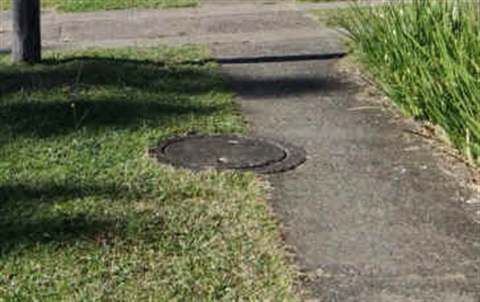Sewer manholes

Sewer manholes are access points to Council’s sewer mains.
They're used to check the condition of sewers, clear blockages in sewer lines and to investigate and fix problems.
Sewer access holes are found in roads, footpaths, driveways, public spaces and on private properties. They are usually found where the sewer changes direction and where 2 or more sewers join together.
Access holes are considered a 'confined space' and only those qualified and authorised by Council can enter.
Unless you're unauthorised, never open a manhole lid.
Council owns and maintains manholes and may need access for maintenance or repairs. Some manholes and sewer mains have easements over them.
Inspections
Council carries out regular inspections to make sure manholes are accessible and visible.
Inspectors check for leaks, tree roots and blockages and make sure stormwater is not being directed into them.
Inspectors also check the flows received in catchments to find potential infiltration problems.
Your responsibilities
You must provide clear access to manholes on your property.
Never bury a manhole or put a large object over it, they must be visible and accessible.
If a manhole on your property is not accessible, Council may direct you to make it accessible (or do work on your behalf).
For example, if a garden bed has been built over a manhole, the property owner will need to remove it to restore access. In some cases excavation may be required.
During construction
Property owners, builders, developers and consultants must consider services that exist on the land, including the position of manholes and sewerage infrastructure.
Manholes must be accessible at all times and must not be damaged during construction.
Other than Council employees or contractors, no one is allowed to carry out work on Council owned sewerage infrastructure (including sewer manholes) unless approved under Section 68 of the Local Government Act 1993.
If you're doing any work next to our sewer infrastructure read Council utilities - work in proximity(PDF, 132KB). Structures built without consideration of this policy are considered illegal in most cases.
Restricted access to manholes
Council will take one of the following actions if a property owner or resident has restricted access to a manhole:
Low risk level
Description: Access is not impeded, minor obstruction or clearing needed to regain access to lid.
Example: Demountable shed without structural floor, Garden bed built over sewer.
Action: Council will send a letter to the property owner requesting them to reinstate access to manhole. Council may assist. Alternatively for easy-to-fix lids, Council will carry out the work with verbal notification and leave a notice for the resident regarding the work carried out.
Medium risk level
Description: Buried manholes in private property.
Example: Manholes that are buried by more than 200mm of fill or under concrete slab or driveway.
Action: Council will raise manhole to surface level. Council will pursue the appropriate responsible person to recover the cost of raising the manhole.
High risk level
Description: Permanent structures built over manhole.
Example: Retaining wall, building or footings that do not meet policy requirements or are within an easement.
Action: Any structure within an easement is illegal. Any structure compromising manhole access will be removed at the cost of the property owner. Where it is considered by Council that immediate removal is not necessary, the property owner will be notified in writing. The structure can remain at Council discretion and if Council requires access, Council shall remove the structure or obstruction at that time at the owners expense.
A notation may also be placed on Council's property information system and may be available on a section 10.7 certificate (formerly S149) for future prospective buyers of the property.